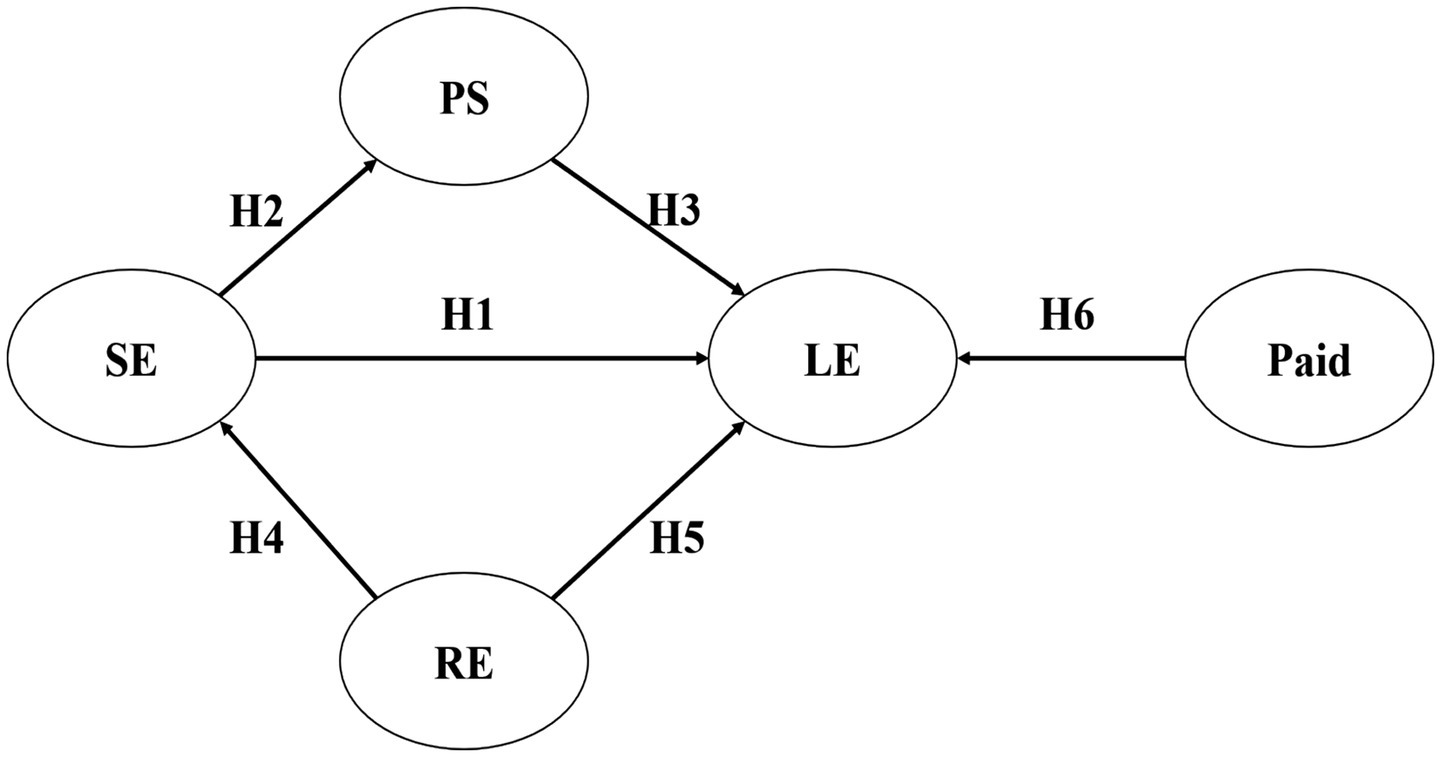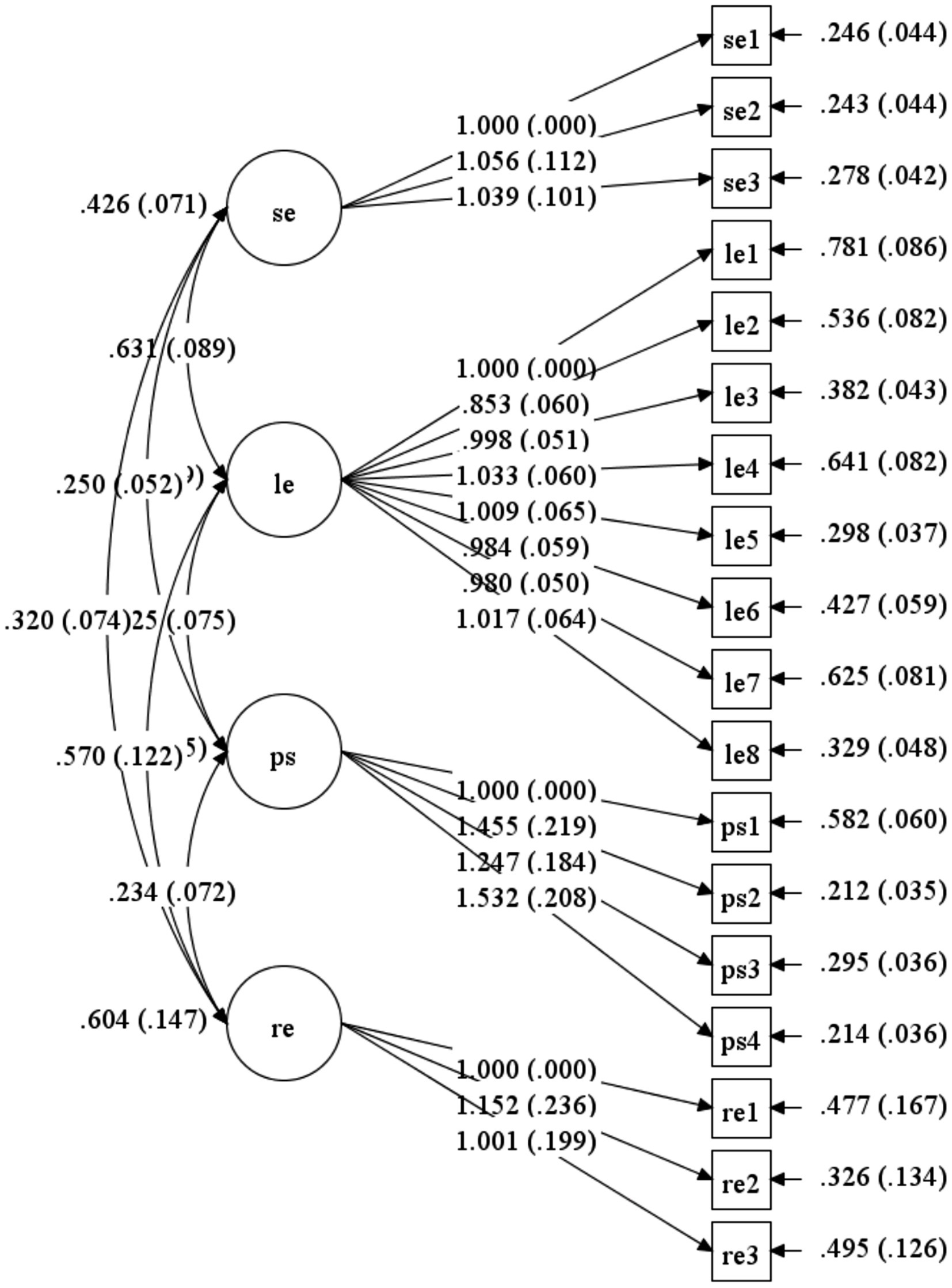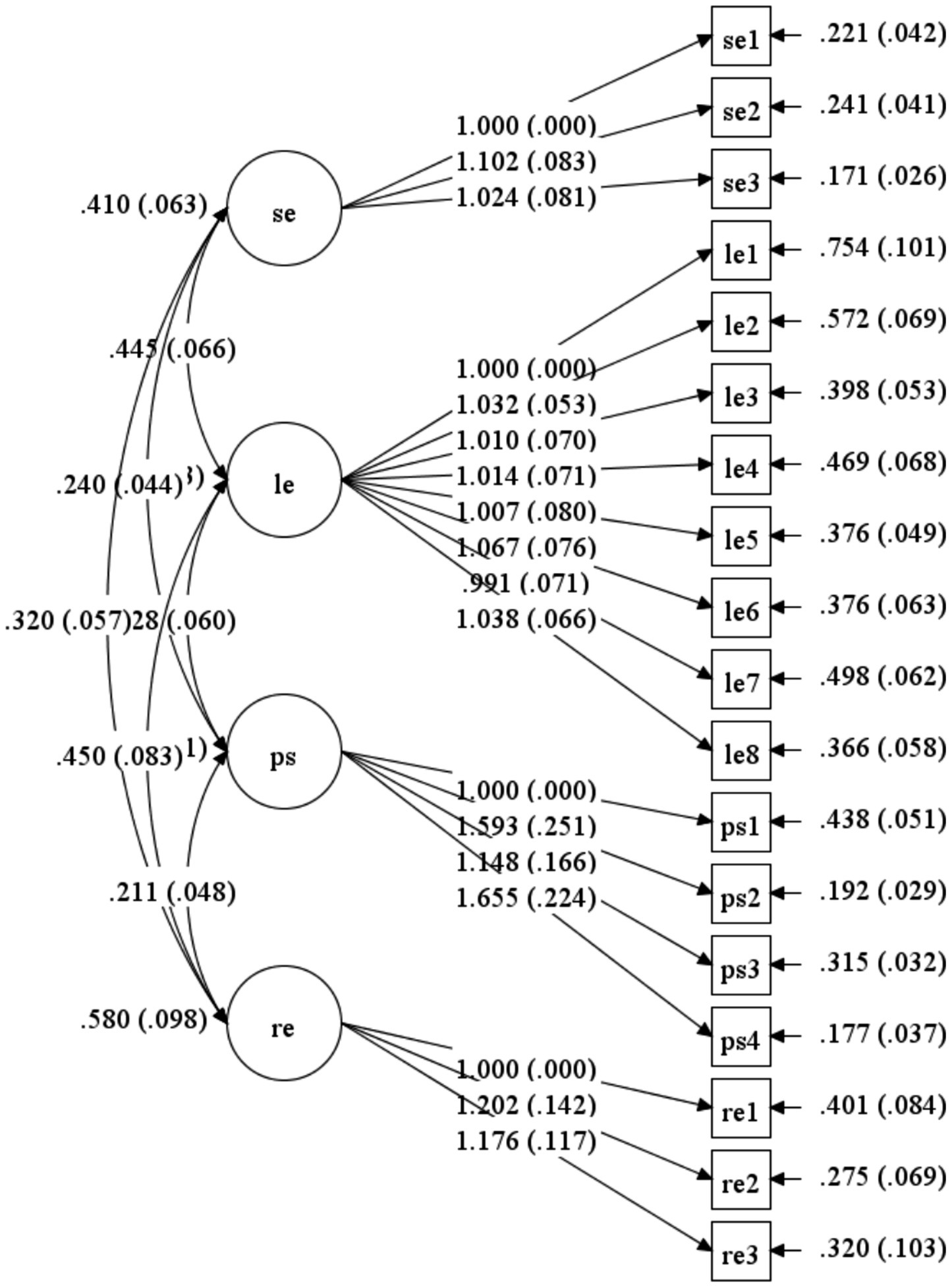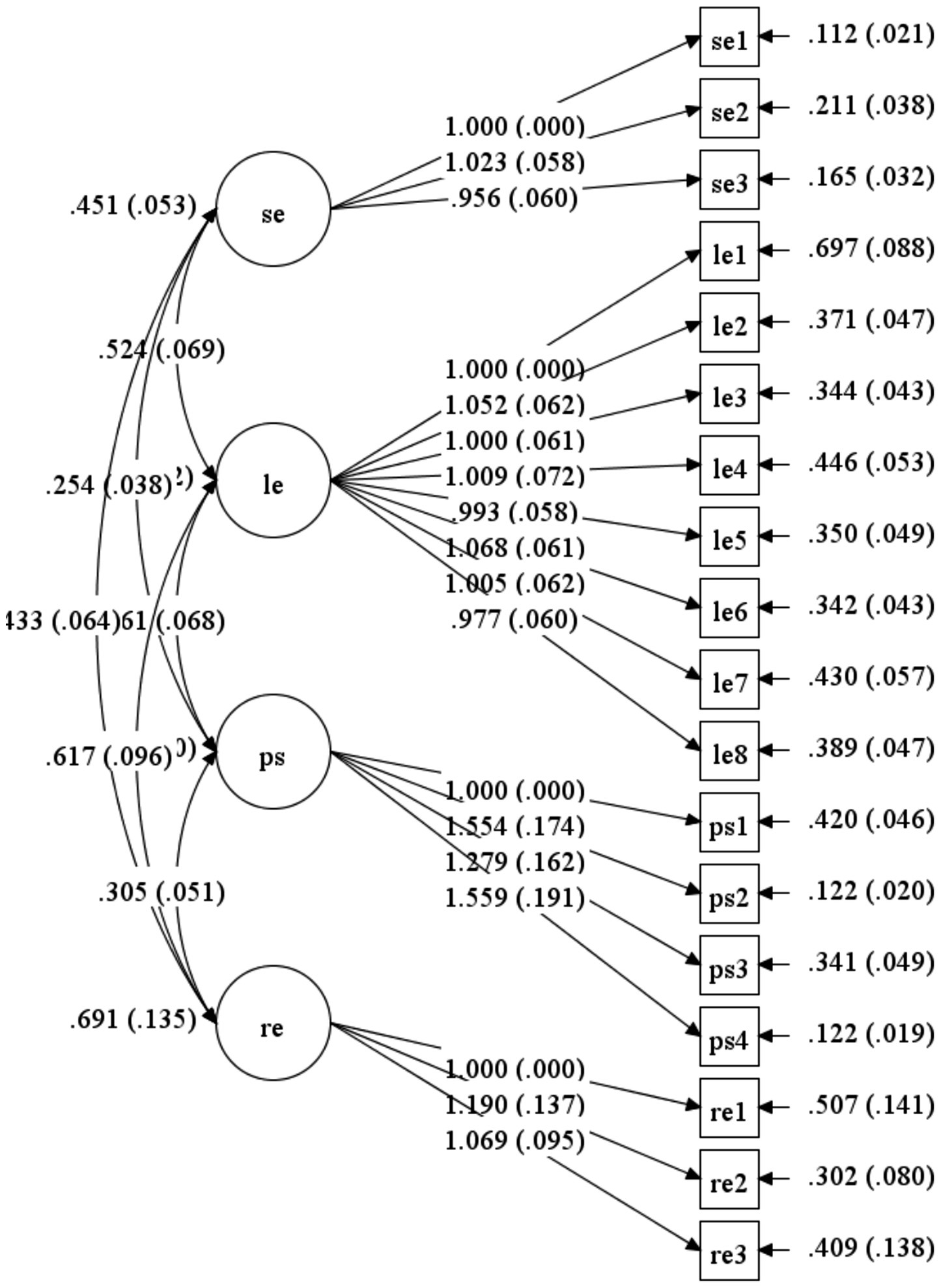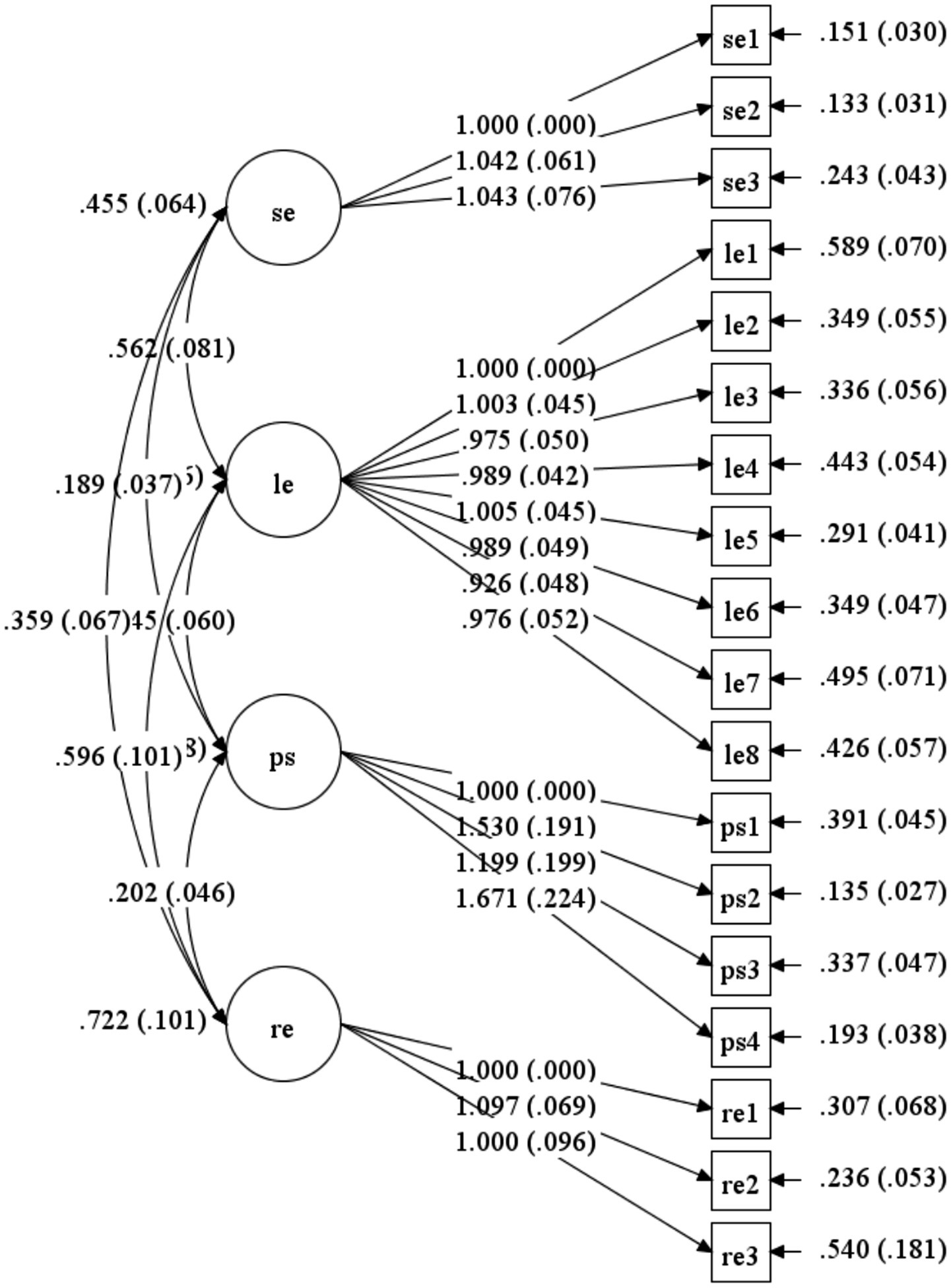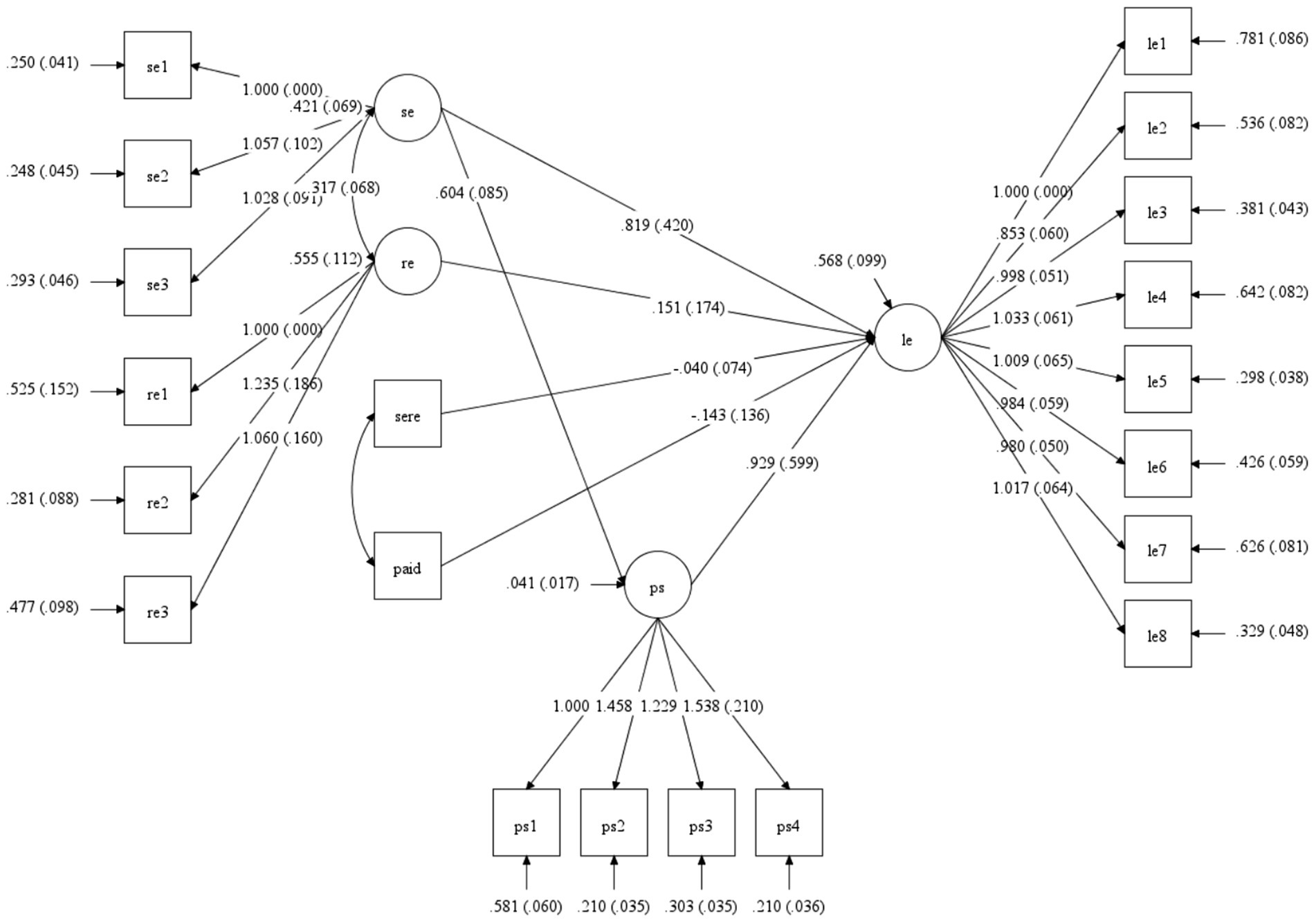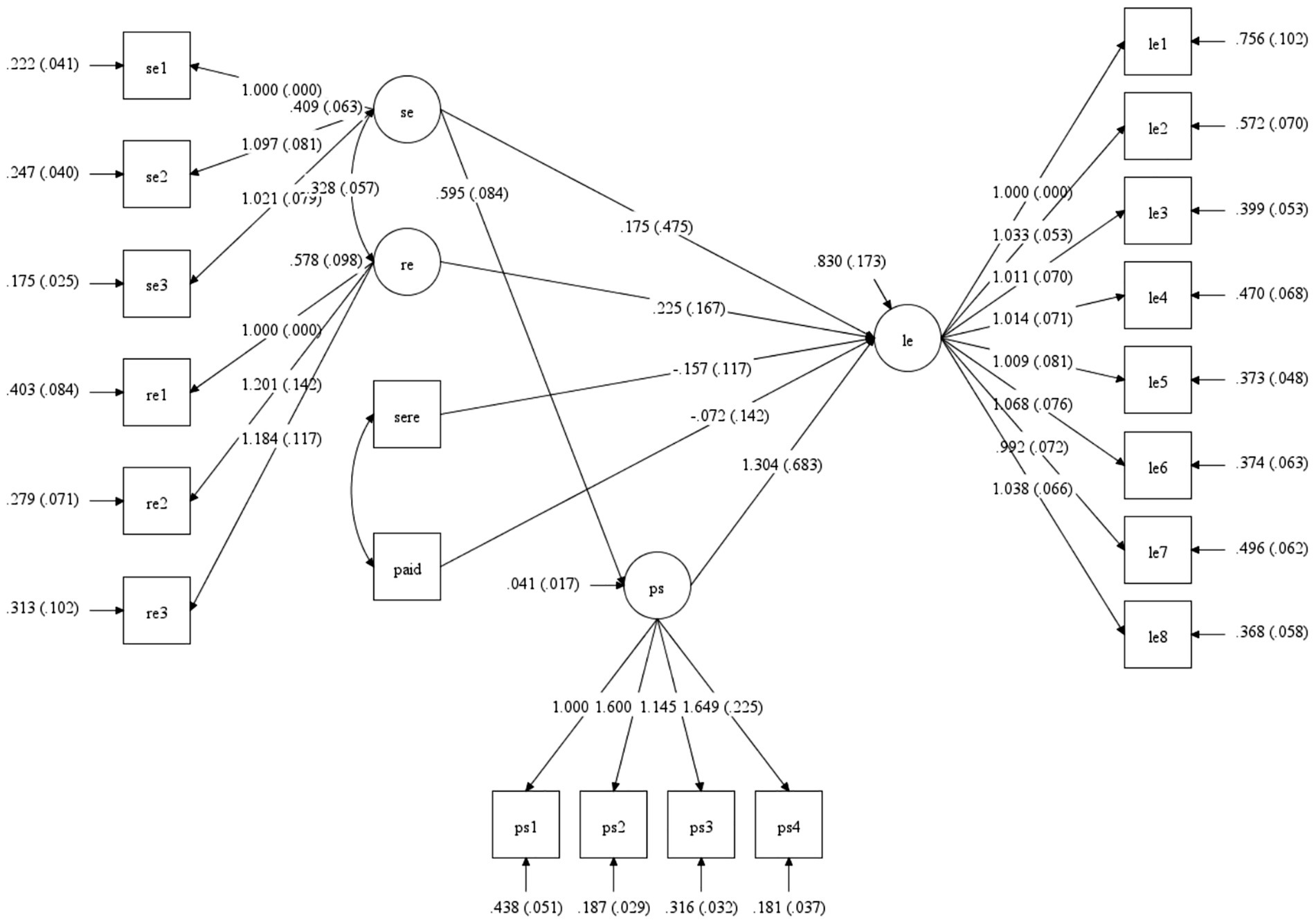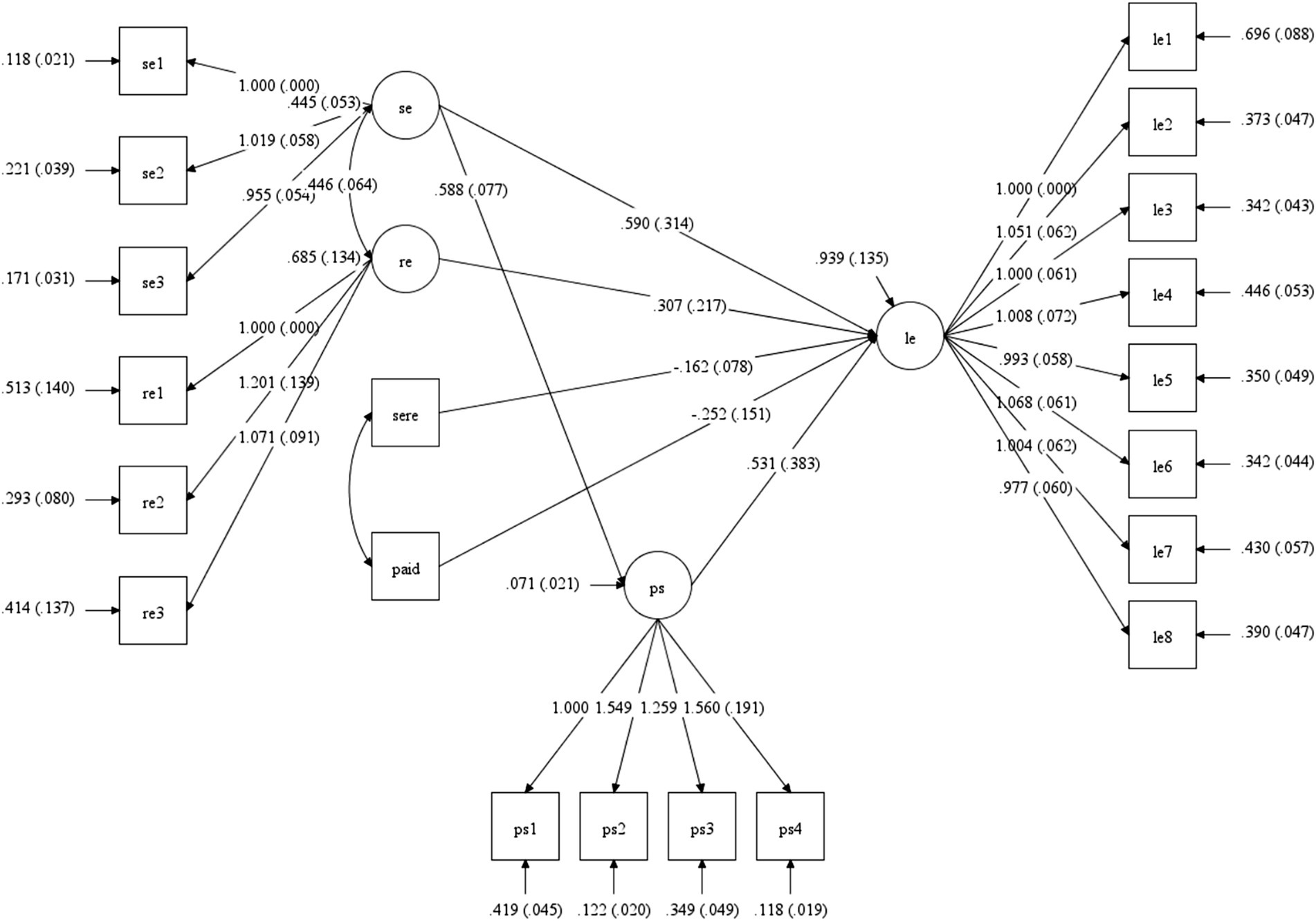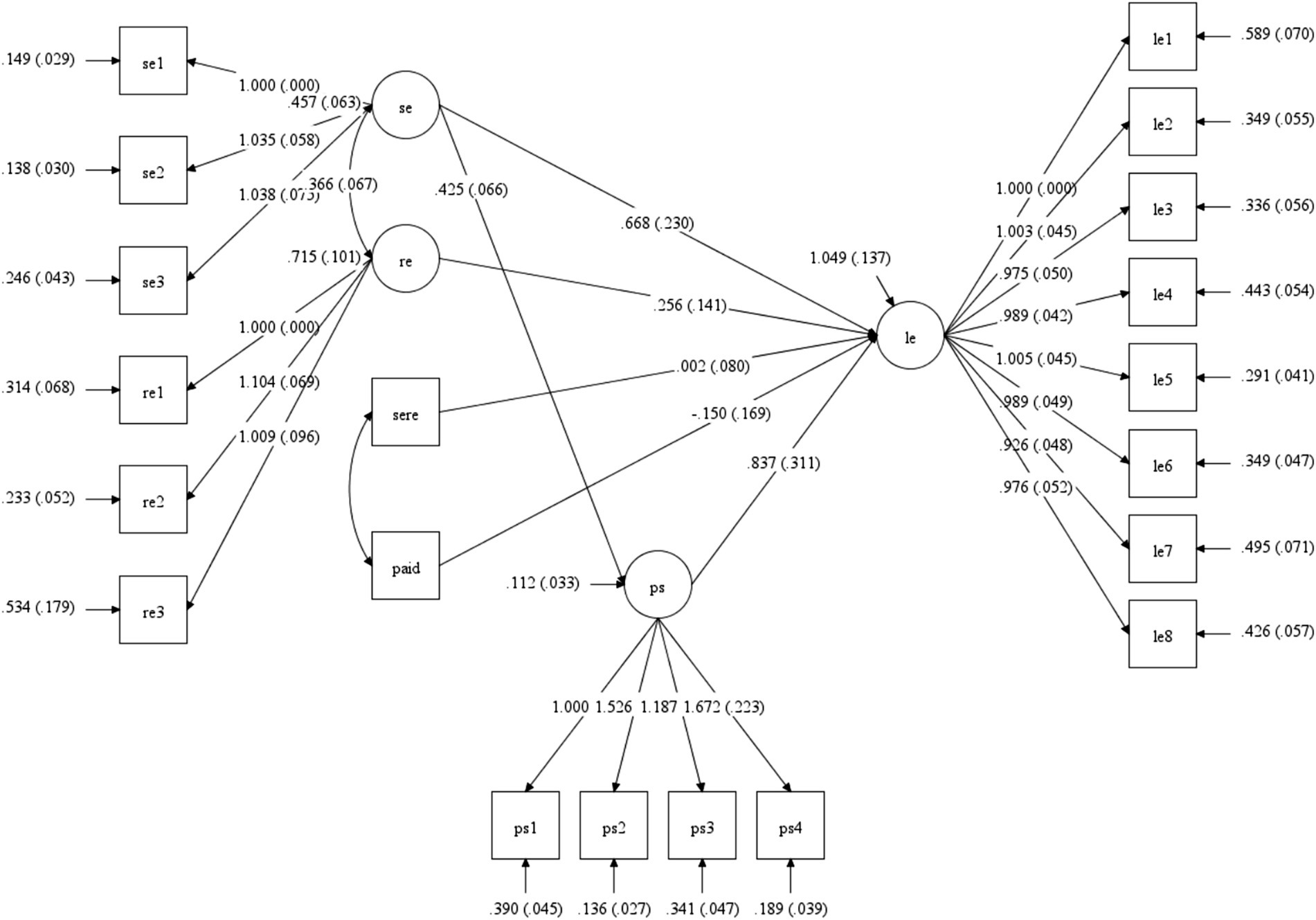- 1Department of Supply Chain and Information Management, School of Decision Science, The Hang Seng University of Hong Kong, Siu Lek Yuen, Hong Kong SAR, China
- 2Employment and Entrepreneurship Center, Shandong Vocational and Technical University of Foreign Studies, Rizhao, China
The present study investigates the participation of 235 students from the Department of Supply Chain and Information Management at a university in Hong Kong in four training workshops focused on Enterprise Resource Planning (ERP) Systems. After each workshop, relevant questionnaire surveys were administered to gather data on students’ learning experiences and key variables, including self-efficacy, learning efficacy, passion, and resilience. The collected data were analyzed using structural equation modeling (SEM) to explore the interrelationships among these variables within the context of ERP systems training. The findings indicate that after completing a series of four ERP systems training workshops, participants with a bachelor’s degree and those receiving compensation demonstrated significant improvements in these four dimensions. These results underscore the pivotal role of self-efficacy as a motivational driver for learning and highlight the interplay between intrinsic motivation and external rewards in fostering passion for learning. Furthermore, the study reveals the dynamic nature of the relationship between passion and learning efficacy. In the initial stages of training, students exhibited high levels of engagement fueled by curiosity about the ERP systems. However, as task complexity increased, participants encountered greater challenges, which potentially diminished their enthusiasm and engagement. While external incentives, such as financial compensation, are traditionally considered effective motivators, this study found that the negative path coefficient associated with external rewards did not reach statistical significance. This suggests that the design of educational interventions should carefully balance internal and external motivational factors to maximize the effectiveness of ERP systems training. Moreover, this study provides valuable insights into the interrelationships among self-efficacy, learning efficacy, passion, and resilience within the context of ERP systems training. It also offers theoretical guidance for the development of future educational practices aimed at enhancing learning outcomes in ERP systems. This study is limited by the use of self-report measures and its focus on a single institutional context. Future research should broaden the sample and integrate objective performance metrics.
1 Introduction
1.1 Introduction to enterprise resource planning systems
Enterprise Resource Planning (ERP) systems are integrated software solutions that manage and streamline a company’s core business processes, including finance, human resources, supply chain, and customer relationship management. By consolidating various functions into a single system, ERP systems enhance the efficacy and accuracy of data processing, enabling organizations to make informed decisions based on real-time information. In modern business operations, the significance of ERP systems cannot be overstated; they facilitate improved resource management, foster collaboration across departments, and ultimately contribute to a company’s agility and competitiveness in a rapidly changing market.
The purpose of this literature review is twofold. First, it aims to explore how ERP systems assist logistics companies in optimizing their operations. By examining the role of ERP in enhancing visibility, improving inventory management, and streamlining communication within the supply chain, the review will highlight the transformative impact of these systems on logistics performance. Second, the review will investigate how students learn to use ERP systems, focusing on educational methodologies, curriculum designs, and the incorporation of practical training. Understanding how future professionals are trained in ERP usage is crucial, as it ensures that they are well-equipped to leverage these systems effectively in their careers, thus bridging the gap between academic knowledge and real-world application.
ERP systems integrate various functions, such as inventory management, transportation, and financial reporting, to streamline operations. Wulandari and Maulana’s (2023) study underscored the importance of adopting a well-suited ERP system, such as Oracle NetSuite, for logistics companies aiming to enhance operational efficiency and financial reporting capabilities. Integration facilitated seamless communication between departments by centralizing data, which reduced redundancy and enhanced collaboration. As a result, organizations experienced improved operational efficiency. This responsiveness was particularly crucial during emergencies, where timely delivery of aid was essential. Li and Wu’s (2021) study posited that the implementation of an ERP systems has the potential to enhance customer satisfaction by up to 86.7%, a significant figure within the field of study. The ERP systems has been shown to facilitate effective monitoring of supply chain performance, enable the identification of bottlenecks, and ensure a swift response to market changes. Lukyanova et al. (2022) emphasized the need for organizations to carefully select the type of ERP systems that aligned with their specific operational needs to maximize impact.
1.2 Importance of ERP systems on education
Real-time data access provided by ERP systems is crucial for decision-making and operational efficiency. By utilizing vast amounts of structured and unstructured data, organizations can achieve greater accuracy in insights compared to traditional methods, allowing for informed decisions about inventory levels, market demand, and supplier performance. This enhanced accuracy contributes to improved operational outcomes. Additionally, data analytics enables proactive risk management by identifying potential disruptions, such as supplier delays or transportation bottlenecks, allowing organizations to take preventative measures. With data-driven insights, companies can optimize resource allocation by analyzing demand patterns and supply chain performance metrics, ensuring that resources are used efficiently to meet customer demand while minimizing costs. Kolev and Otsetova (2022) gave an example: ERP systems enhance distribution by enabling freight companies to manage their flow accurately and keep suppliers, drivers, distributors, and retailers aligned through real-time information on traffic and customer addresses. Additionally, real-time vehicle tracking provides valuable business intelligence, allowing logistics businesses to keep customers updated during transit. In today’s fast-paced environment, agility and adaptability are vital; real-time data allows organizations to adjust strategies swiftly, maintaining a competitive edge. Furthermore, data analytics provides strategic insights that drive long-term growth by identifying market trends and new opportunities for expansion and innovation. Ultimately, a data-driven approach fosters a culture of continuous improvement, enabling organizations to learn from past decisions and refine their practices over time.
The growing significance of ERP training in business education programs reflects the increasing reliance on integrated systems within organizations. As companies adopt ERP solutions to streamline operations, it is essential for students to understand these tools to remain competitive in the job market. Incorporating ERP education into the curriculum equips future professionals with the skills needed to navigate complex business environments effectively.
Hands-on training is crucial for enhancing learning experiences in ERP education. Practical approaches, such as simulations and real-world projects, allow students to engage with ERP systems directly, fostering a deeper understanding of their functionalities and applications. By working on case studies or participating in project-based learning, students can apply theoretical knowledge to practical scenarios, preparing them for real-world challenges.
Additionally, online resources and tools play a vital role in facilitating ERP learning. Various platforms offer interactive tutorials, webinars, and access to ERP software, enabling students to explore the systems at their own pace. These resources enhance flexibility and accessibility, making it easier for learners to acquire the knowledge needed to effectively utilize ERP systems in their future careers. This review highlights how ERP systems enhance logistics operations and how students acquire ERP competencies through hands-on education.
1.3 Challenges in learning ERP systems
One of the primary challenges students face when learning ERP systems is the complexity of the software interfaces. ERP systems often encompass a wide range of functionalities, making them intimidate for newcomers. The intricate navigation and diverse modules can overwhelm students, hindering their ability to grasp the systems’ full potential. To overcome this, educational programs need to provide structured training that breaks down these complexities into manageable components, allowing students to build their confidence gradually.
Another significant challenge is the integration of ERP training into existing educational curricula. Many institutions may lack the resources or expertise to effectively incorporate ERP systems into their programs. To address this, schools should collaborate with ERP vendors and industry professionals to develop comprehensive training modules that align with real-world applications. Additionally, offering dedicated courses or workshops focused on ERP system scan ensure that students receive the hands-on experience necessary for mastering these tools. By prioritizing ERP education within the curriculum, educational institutions can better prepare students for the demands of the modern workforce.
1.4 Assessment and continuous improvement
Various methods can be employed to assess students’ understanding and proficiency with ERP systems. These include project-based assessments, written examinations, and industry-recognized certifications, each providing valuable insights into students’ practical and theoretical knowledge. Additionally, conducting surveys to gather students’ reflections on their learning effectiveness can further enrich the evaluation process.
Ensuring that academic programs meet consistent quality standards across different educational systems poses a significant challenge (Waham et al., 2023). The data collected from surveys can effectively address this issue by enabling a comprehensive analysis of learning outcomes. This analytical approach provides a quantitative method for evaluating module performance, allowing educational institutions to identify areas for improvement and adapt their curricula to better meet student needs. By implementing these assessment techniques, educators can ensure that students acquire the essential skills and competencies required to excel in the field of ERP systems. Additionally, enhancing teaching materials and methodologies based on survey data supports continuous improvement in educational quality.
The learning effectiveness of university students in using ERP systems has not been explored in the existing literature. Therefore, this study aims to fill this research gap by conducting a questionnaire survey study over the past 3 years, targeting at students in a university in Hong Kong, to investigate their learning effectiveness in using the ERP systems.
2 Research modeling construction
Scholars studied from the perspective of information technology and construct research models to explore the relationship between the influencing factors and their internal mechanisms. Teng et al. (2022) Changeling constructed a model of the influence of perceived interactivity and learner experience on the willingness to continue learning based on Stimulus-Organism-Response (S-0-R) and technology acceptance model and analyzed the influence of instructor support on the willingness to learn online. Scholars combined the technology acceptance model and Mathieson’s Perceived Resources and Technology Acceptance Model (PRATAM) to construct a research model on willingness to study in colleges and universities in terms of three types of variables, namely external variables, perceived variables, and output variables, and emphasized the importance of course design and sense of belonging to the community (Astiti et al., 2023).
Based on the analysis of the literature, the technology acceptance model has good applicability to digital learning, distance education, and online learning (Tao et al., 2022). To validate the significance and implementation of education and teaching, the SEM model was constructed as the best representation of the factors in educational outcomes (Al-Adwan et al., 2021).
As mentioned in the above, the existing literature has not examined the learning effectiveness of the ERP systems, therefore, this study builds a new research model with reference to the theoretical frameworks proposed by other education scholars in order to provide an in-depth exploration of the effectiveness of the students’ performance and the factors associated with the learning process of this systems. This research framework will help fill the research gap in this area and provide deeper insights into understanding students’ performance and experience in learning the freight operating systems. The hypothesized model is as follows (Figure 1).
2.1 Characteristics of ERP systems learning effectiveness
The learning efficacy of ERP systems is of great significance to students, and it directly affects the effectiveness of their learning of the systems. Appropriate learning planning and self-efficacy provide a solid foundation for learning the systems. Meanwhile, students’ passion for learning the systems and their resilience in the face of difficulties and challenges in the learning process are crucial for motivating students to learn the ERP systems. Collectively, these elements influence students’ attitudes, drive, and probability of achieving success in mastering the ERP systems. Therefore, the following hypotheses were carried out in this study.
Hypothesis H1. Self-efficacy directly influences learning efficacy.
Hypothesis H2. Pelf-efficacy directly influences passion.
Hypothesis H3. Passion directly influences learning efficacy.
Hypothesis H4. Resilience directly influences self-efficacy.
Hypothesis H5. Resilience directly influences learning efficacy.
2.2 Factors influencing in ERP systems learning effectiveness
This study involved students from the summer program, some of whom were compensated for their participation, while others volunteered without compensation. The study posits that the method of compensation for study involvement could influence their efficacy performance regarding learning outcomes in ERP systems. This hypothesis aims to help on the potential influence of various incentives on students’ learning behavior and effectiveness.
Hypothesis H6. Paid factor directly affects learning efficacy.
3 Methodology and research design
3.1 Data sample
The study sample was drawn from a full-time non-profit university in Hong Kong and covered a total of 235 students enrolled in the Department of Supply Chain and Information Management, with 194 (83%) undergraduates (bachelor’s degree) and 41 (17%) master’s students. The sample included 140 (60%) students who participated voluntarily and 95 (40%) summer students who participated by being paid. This cohort of students participated in four learning workshops (respectively, Time 1, Time 2, Time 3, and Time 4) regarding the ERP Systems course training over a period of almost 3 years from September 2020 to March 2024 and completed questionnaires survey at the end of each learning event. Due to the long duration of the four workshops, some of the students did not successfully complete all the questionnaires after the completion of the systems training course, therefore, this study statistically concluded that a total of 182 (77%) students completed the questionnaires after the four learning workshops, while 53 (23%) did not complete the questionnaires in their entirety.
3.2 Methodology
The study collected data using a questionnaire survey method and processed the data using the structural equation modeling (SEM). By employing the Mplus tool to effectively gather and analyse survey data, indicators such as the chi-square value (X), chi-square degrees of freedom ratio (X/df), comparative fit index (CFI), goodness of fit index (GFI), and root mean square error of approximation (RMSEA) were utilized to assess the fit validity of the structural equation models. RMSEA is a crucial absolute fit index, where a value less than 0.08 indicates a good model fit, and less than 0.05 suggests an excellent fit. CFI and GFI serve as primary relative fit indices, with values ideally exceeding 0.90. The chi-square degrees of freedom ratio (X/df) are a key parsimony fit index, typically falling between 1 and 3, with a stricter criterion of less than 2 indicating an acceptable fit between the hypothesized model and the data sample. In this study, four SEM models at different time points will be constructed based on the questionnaire survey results following students’ participation in four distinct workshops.
3.3 Measure instrument
The survey questionnaire utilized in this study is based on the Likert scale, encompassing aspects such as self-efficacy, learning efficacy, passion, and resilience. These questionnaire items were primarily inspired by research on self-efficacy, learning efficacy, passion, and resilience conducted by studies Jones (1986), Zimmerman et al. (1992), Carbonneau et al. (2008), and Windle et al. (2011). Specifically, self-efficacy comprises 3 items, learning efficacy comprises 8 items, passion comprises 4 items, and resilience comprises 3 items, totaling 18 items. Table 1 provides a detailed overview of the sources of the survey questionnaire and the questionnaire reliability (due to the varying number of students participating in the survey after each of the four workshops, this study conducted a reliability assessment of the questionnaire on four separate occasions). The design of this survey tool aims to comprehensively evaluate students’ self-perception, learning attitudes, and psychological capabilities during the learning process on ERP systems learning.
4 Results
This study conducted questionnaire survey research on the same group of students (N = 235) after four ERP systems training workshops. Due to some students not completing the surveys fully after the conclusion of the learning workshops’ activities at Time 1, Time 2, Time 3, and Time 4, the sample sizes varied after each learning activity. Given this scenario, this study constructed models separately for the data results of students participating in the questionnaire survey after each activity to investigate the relationships between self-efficacy, learning efficacy, passion, and resilience following each workshop. Considering that structural equation modeling (SEM) encompasses both measurement and structural models, this study conducted a detailed analysis of these two types of models (Confirmatory factor analysis and Structural equation modeling).
As a longitudinal study, the present study also endeavor aims to study the interrelationships among self-efficacy, learning efficacy, passion, and resilience, thereby clarifying the learning effectiveness of each ERP systems training intervention. Beyond validating through the construction of SEM models, latent growth models (LGM) were employed to observe the developmental trend of these four variables. This approach facilitates a deeper understanding of the evolution and interplay of these variables within the learning process, offering researchers a more comprehensive perspective and insights. Such a research design not only uncovers the impact of ERP systems training on students’ learning outcomes and self-perceived capabilities but also provides valuable theoretical guidance and practical recommendations for educational practice.
4.1 Confirmatory factor analysis results
4.1.1 The CFA results of the four variables after the first training
Based on the model and the results presented in Table 2, the fit indicators of the confirmatory factor analysis model demonstrate satisfactory performance. Specifically, the CMIN/DF value of the model is less than 3, while both the TLI and CFI indices exceed 0.9. Additionally, the RMSEA and SRMR values are both below 0.08. These results indicate that the majority of fit indicators meet the established criteria, reflecting a strong fit and adaptability of the model (Figure 2; Table 3).
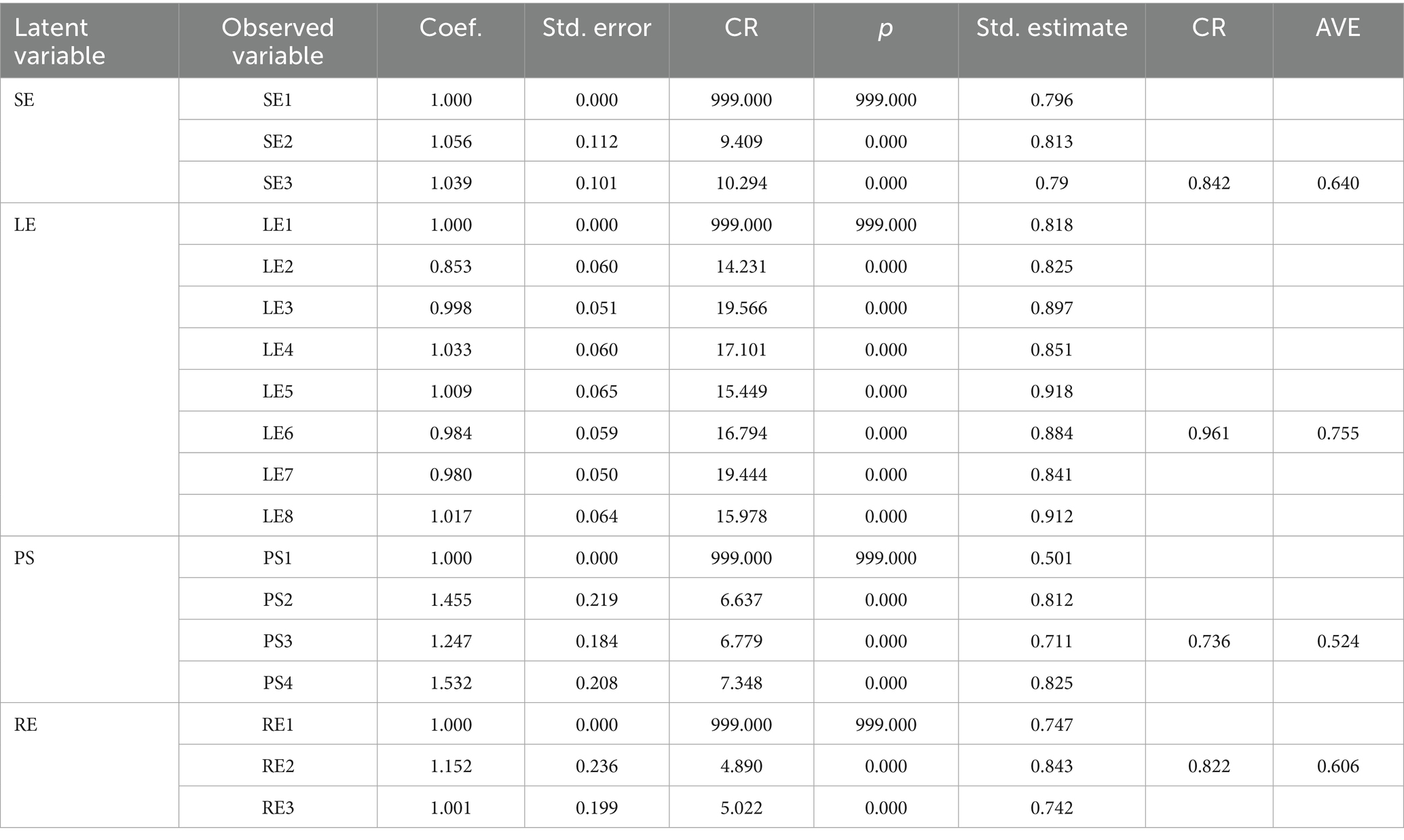
Table 3. Factor loadings, composite reliability (CR), and average variance extracted (AVE) in measurement (time 1).
The table of factor loadings illustrates the relationships between the factors and their corresponding measurement items, typically analyzed through standardized loading coefficients. Overall, all measurement items demonstrated significant levels (p < 0.001), with most standardized loading coefficients exceeding 0.6, although the standardized loading coefficient for PS1 was slightly below 0.5. This indicates a strong correspondence between the factors and the measurement items, thereby suggesting good convergent validity.
The measurement results presented in the table indicate that when AVE values exceed 0.5 and CR values are above 0.7, it suggests that the data possess good convergent validity. This means that the latent variables can effectively explain the measurement items, which accurately reflect the characteristics of the latent variables, thereby ensuring the credibility and validity of the model.
Table 4 shows that the square root values of the Average Variance Extracted (AVE) for most factors are higher than the maximum absolute values of the inter-factor correlation coefficients, indicating that they possess good discriminant validity.
4.1.2 The CFA results of the four variables after the second training
From the model and the table above, it can be observed that the CMIN/DF is less than 3, TLI and CFI are greater than 0.9, and RMSEA and SRMR are both less than 0.08. Most of the model fit indices meet the criteria, indicating that the model fits well (Figure 3; Table 5).
Table 6 illustrated that all measurement indicators demonstrate a significance level of 0.001 (p < 0.001). Furthermore, most standardized loading coefficients are above 0.6, although the standardized loading coefficient for PS1 is slightly lower but still exceeds 0.5. This indicates a strong correspondence between the factors and the measurement indicators overall, thereby ensuring good convergent validity. The AVE values are greater than 0.5, and the CR values are all above 0.7, suggesting that the model possesses good convergent validity.
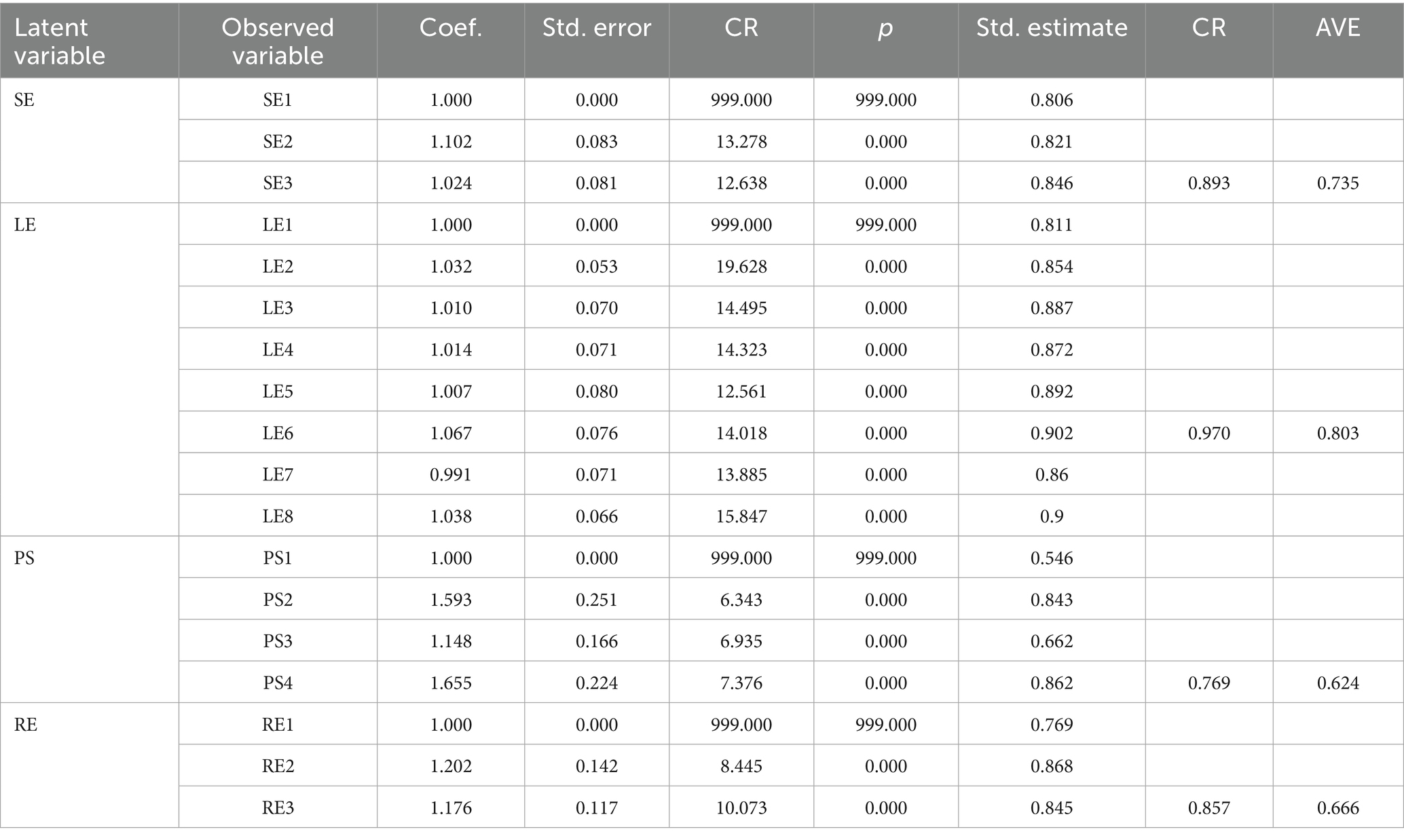
Table 6. Factor loadings, composite reliability (CR), and average variance extracted (AVE) in measurement (time 2).
Table 7 presents that the square root values of the Average Variance Extracted (AVE) for most factors exceed the maximum absolute values of the inter-factor correlation coefficients, indicating that these factors possess good discriminant validity.
4.1.3 The CFA results of the four variables after the third training
From Table 8, it can be seen that the CMIN/DF is less than 3, TLI and CFI are greater than 0.9, and RMSEA and SRMR are both less than 0.08. Most of the model fit indices meet the criteria, indicating that the model fits well (Figure 4).
From Table 9, all measurement items demonstrate a significance level of 0.001 (p < 0.001), and most standardized loading coefficients exceed 0.6, although the standardized loading coefficient for PS1 is slightly lower yet still above 0.5. This indicates a strong correspondence between the factors and the measurement items overall, thereby ensuring good convergent validity. Furthermore, the AVE values are all greater than 0.5, and the CR values are all above 0.7, which means that the model exhibits excellent convergent validity.
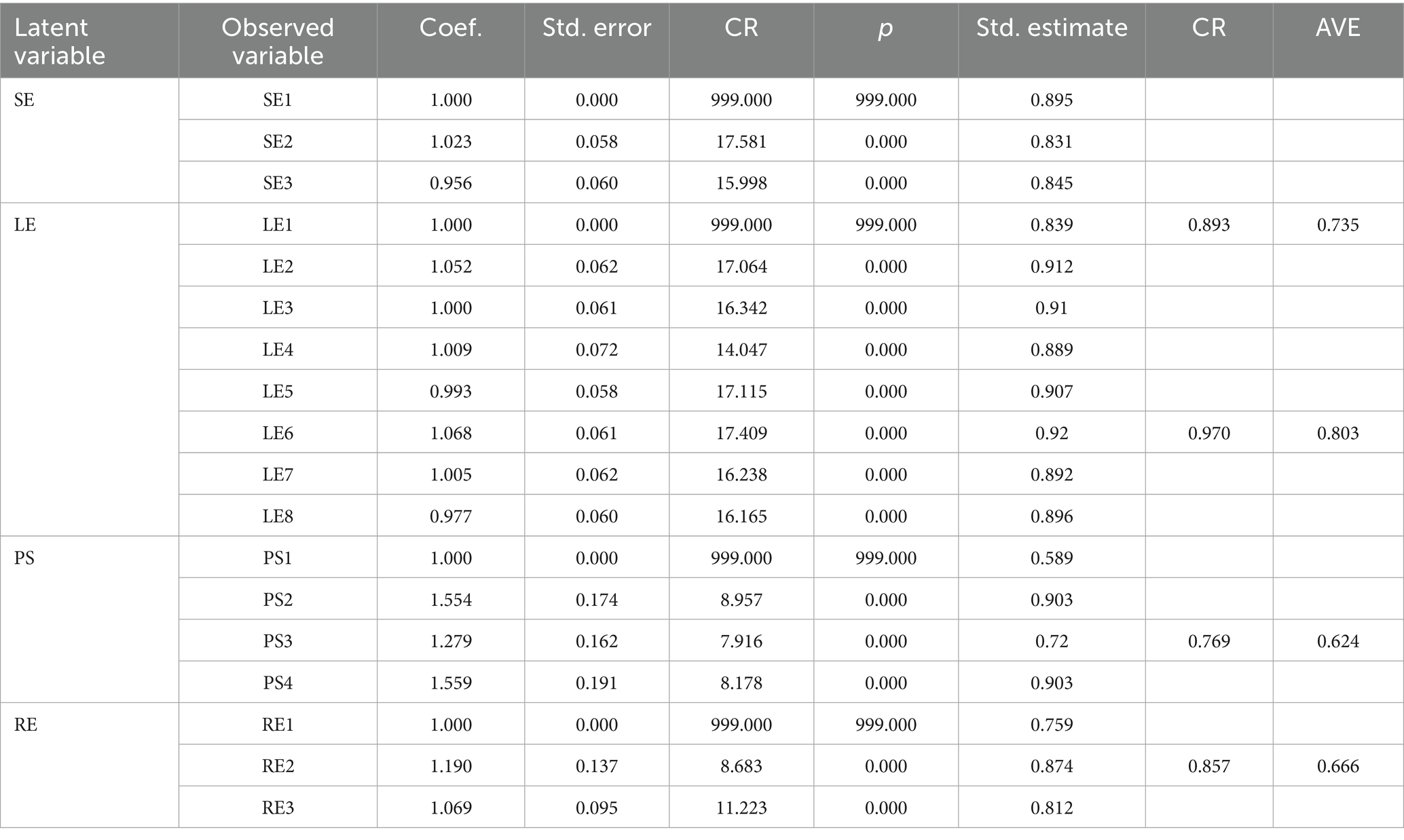
Table 9. Factor loadings, composite reliability (CR), and average variance extracted (AVE) in measurement (time 3).
Table 10 shows that the square root values of the Average Variance Extracted (AVE) for most factors exceed the maximum absolute values of the inter-factor correlation coefficients, indicating that these factors possess good discriminant validity.
4.1.4 The CFA results of the four variables after the fourth training
From Table 11, it can be observed that the CMIN/DF is less than 3, TLI and CFI are greater than 0.9, and RMSEA and SRMR are both less than 0.08. Most of the model fit indices meet the criteria, indicating that the model fits well (Figure 5).
The results in the table indicate that all measurement items exhibit a significance level of 0.001 (p < 0.001), and most standardized loading coefficients are greater than 0.6 (with PS1 having a slightly lower standardized loading coefficient still above 0.5) (Table 12). This suggests that, overall, there is a strong correspondence between the factors and the measurement items, indicating good convergent validity. Furthermore, the AVE values are greater than 0.5, and the CR values are all above 0.7, which means that the model possesses good convergent validity.
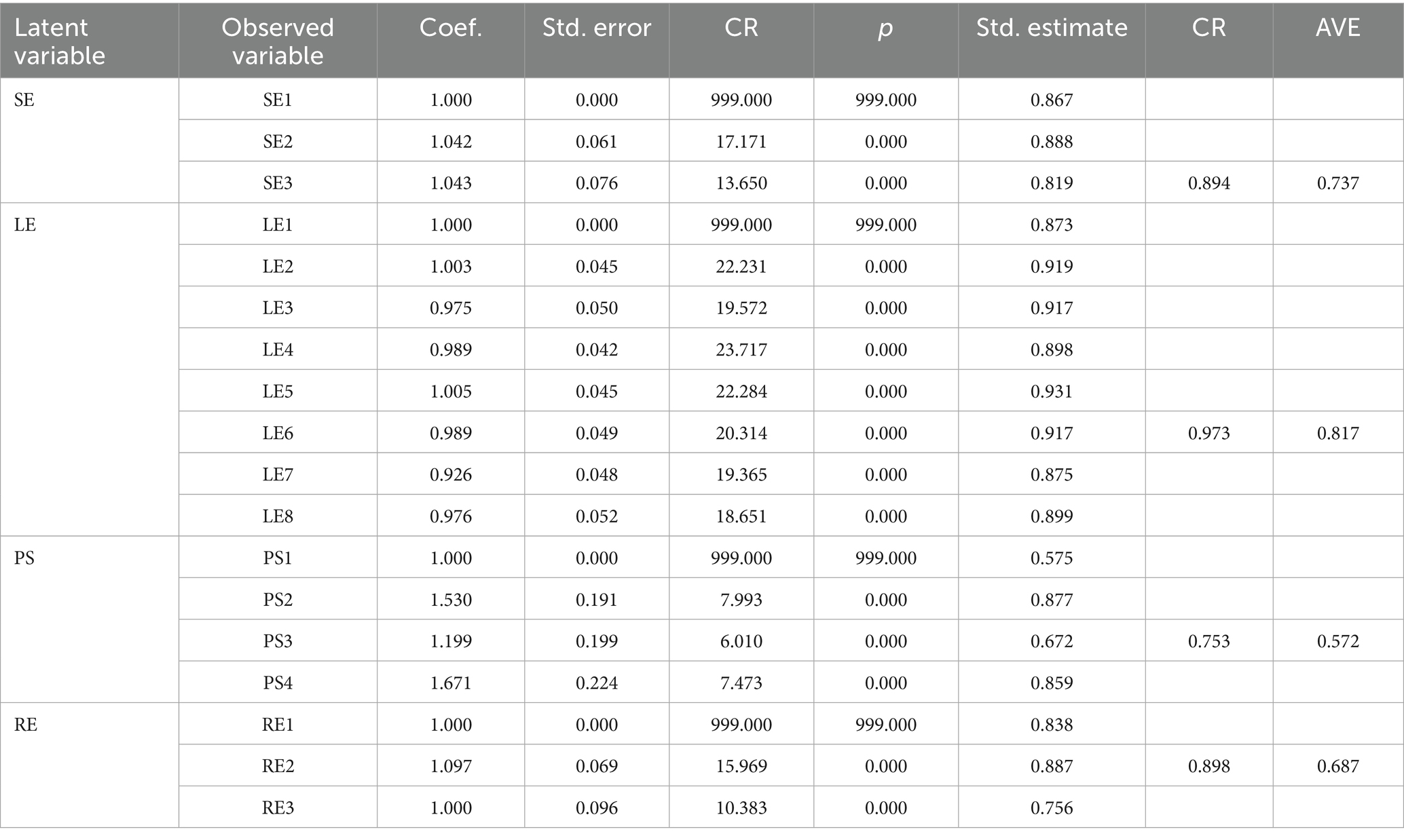
Table 12. Factor loadings, composite reliability (CR), and average variance extracted (AVE) in measurement (time 4).
Table 13 illustrates that the square root values of the AVE for most factors are greater than the maximum absolute value of the inter-factor correlation coefficients, indicating that they exhibit good discriminant validity.
4.2 Structural equation model analysis results
4.2.1 Structural equation model among four variables after students’ first ERP systems training
According to Table 14, the fit indicators of the structural equation model demonstrate satisfactory results: CMIN/DF is less than 3, TLI and CFI are both greater than 0.9, and RMSEA and SRMR are both below 0.08. These indices indicate that the model’s fit meets the standards and that the overall fit is good. The strong performance of this model fit suggests that the constructed theoretical model has good adaptability and explanatory power in elucidating the relationships among the variables.
According to Table 15, when considering the effect of SE on LE, the standardized path coefficient is 0.447, which is greater than 0, and this path shows significance at the 0.05 level (p = 0.043 < 0.05). This indicates that SE has a significant positive impact on PS. In terms of the influence of PS on LE, the standardized path coefficient is 0.314, which is also greater than 0; however, the significance level of this path is 0.134, which exceeds 0.05, suggesting that PS does not have a significant positive impact on LE. Finally, when considering the effect of SE on PS, the standardized path coefficient is 0.889, which is greater than 0, and this path shows significance at the 0.01 level (p = 0.000 < 0.01), indicating that SE has a significant positive impact on PS. Additionally, regarding the influence of PAID on LE, the standardized path coefficient is −0.055, which is less than 0; however, the significance level of this path (p = 0.294 > 0.05) indicates that PAID does not have a significant negative impact on LE.
When conducting mediating effect testing, the first step is to verify whether the total effect of the independent variable on the dependent variable is significant. Next, it is essential to examine the coefficients of the paths from the independent variable to the mediator and from the mediator to the dependent variable; the product of these two paths constitutes the indirect effect, which should be tested for significance. Finally, it is necessary to assess whether the direct effect of the independent variable on the dependent variable is significant, especially when the model includes a mediator. If the 95% confidence interval obtained through bootstrap sampling does not include 0, it indicates that the effect is significant. When both total effect, indirect effect, and direct effect are established, it can be inferred that there exists a partial mediating effect; if the total effect and indirect effect are significant but the direct effect is not, then a complete mediating effect can be concluded. From Table 16, the coefficient of the indirect effect is 0.561, but its p-value is 0.144, which is greater than 0.05. This indicates that the mediating effect is not significant, meaning that PS does not play a significant mediating role in the influence of SE on LE. This finding provides valuable insights that contribute to a deeper understanding of the relationships between variables and underscores the importance of careful consideration and analysis of mediating effects when interpreting complex associations (Table 17).
According to the results presented in the table, the coefficient of the interaction term “SERE” between the independent variable and the moderating variable is −0.022, but the significance level (p = 0.591) is greater than 0.05. Therefore, RE does not play a significant moderating role in the effect of SE on LE (Figure 6).
4.2.2 Structural equation model among four variables after students’ second ERP systems training
From the table above, it can be seen that CMIN/DF is less than 3, TLI and CFI are both greater than 0.9, and RMSEA and SRMR re both less than 0.08. All model fit indices meet the criteria, indicating that the model fits well (Table 18).
According to Table 19, the following conclusions can be drawn from the analysis: When considering the effect of SE on LE, the standardized path coefficient is 0.093. Although this is a positive value, the significance level is 0.710, which is greater than 0.05, indicating that SE does not have a significant positive impact on LE. In terms of the influence of PS on LE, the standardized path coefficient is 0.466, and the significance level is 0.034, which is less than 0.05, suggesting that PS has a significant positive impact on LE. Additionally, when considering the effect of SE on PS, the standardized path coefficient is 0.882, with a significance level of 0.000, which is less than 0.01, indicating that SE has a significant positive impact on PS. Finally, regarding the influence of PAID on LE, the standardized path coefficient is −0.029, which is negative; however, the significance level is 0.611, greater than 0.05, suggesting that PAID does not have a significant negative impact on LE.
From Table 20, the coefficient of the indirect effect is 0.776, with a p-value of 0.044, which is less than 0.05, indicating that the mediating effect is significantly present. Therefore, it can be concluded that PS plays a significant full mediating role in the influence of SE on LE.
Table 21 shows that the coefficient of the interaction term “SERE” between the independent variable and the moderating variable is −0.112, but the significance level (p = 0.138) is greater than 0.05. Therefore, RE does not play a significant moderating role in the effect of SE on LE (Figure 7).
4.2.3 Structural equation model among four variables after students’ third ERP systems training
From Table 22, it can be seen that CMIN/DF is less than 3, TLI and CFI are both greater than 0.9, and RMSEA and SRMR are both less than 0.08. All model fit indices meet the criteria, indicating that the model fits well.
From Table 23, when considering the effect of SE on LE, the standardized path coefficient is 0.305, which is above zero; however, the significance level of this path is 0.055, slightly higher than 0.05, indicating that SE does not have a significant positive impact on LE. In terms of the influence of PS on LE, the standardized path coefficient is 0.195, also above zero, but the significance level is 0.163, exceeding 0.05, which means that PS does not have a significant positive impact on LE. On the other hand, when considering the effect of SE on PS, the standardized path coefficient is 0.827, significantly greater than zero, with a significance level of 0.000, which is less than 0.01, indicating that SE has a significant positive impact on PS. Finally, regarding the influence of PAID on LE, the standardized path coefficient is −0.095, which is negative; however, the significance level is 0.096, exceeding 0.05, suggesting that PAID does not have a significant negative impact on LE.
Table 24 shows that the coefficient of the indirect effect is 0.312; however, its p-value is 0.178, which is greater than 0.05. Therefore, it can be concluded that PS does not play a significant mediating role in the influence of SE on LE.
In the influence of SE on LE, the coefficient of the interaction term “SERE” between the independent variable and the moderating variable is −0.104, with a significance level of 0.035, which is less than 0.05 (Table 25). Therefore, it can be concluded that RE plays a significant negative moderating role in the effect of SE on LE (Figure 8).
4.2.4 Structural equation model among four variables after students’ fourth ERP systems training
From the results in the table above, it can be seen that CMIN/DF is less than 3, TLI and CFI are both greater than 0.9, and RMSEA and SRMR are both less than 0.08. All model fit indices meet the criteria, indicating that the model fits well (Table 26).
When examining the impact of Self-Efficacy (SE) on Learning Effectiveness (LE), the standardized path coefficient is 0.332, which is greater than 0, and it is significant at the 0.05 level (p = 0.004 < 0.05) (Table 27). This indicates that self-efficacy has a significant positive impact on learning efficacy. On the other hand, when studying the influence of Passion for Study (PS) on Learning Efficacy (LE), the standardized path coefficient is 0.271, which is also greater than 0, and it is significant at the 0.05 level (p = 0.005 < 0.05). This suggests that passion for study has a significant positive impact on learning effectiveness. Furthermore, when exploring the effect of Self-Efficacy (SE) on Passion for Study (PS), the standardized path coefficient is 0.652, which is greater than 0, and it is significant at the 0.01 level (p = 0.000 < 0.01). Therefore, self-efficacy has a significant positive impact on passion for study. Finally, when analyzing the influence of PAID on Learning Efficacy (LE), the standardized path coefficient is −0.054, which is less than 0; however, the significance level is p = 0.373, which is greater than 0.05. This indicates that PAID does not have a significant negative impact on learning effectiveness.
From Table 28, the coefficient of the indirect effect is 0.356, with a corresponding p-value of 0.005, which is less than 0.05. Based on this, it can be concluded that PS plays a significant partial mediating role in the influence of SE on LE. This finding underscores the importance of PS in the process of transmitting the effect of SE on LE and provides key insights for understanding the complex relationships among the variables in the model.
In the influence of SE on LE, the coefficient of the interaction term “SERE” between the independent variable and the moderating variable is 0.001, with a corresponding p-value of 0.978, which is clearly higher than 0.05 (Table 29). Therefore, it can be concluded that RE does not play a significant moderating role in the effect of SE on LE. This result emphasizes that under the current research conditions, RE does not have statistically significant effects on the relationship between SE and LE, providing important insights for further understanding the relationships among the variables (Figure 9).
5 Discussion
5.1 The impact of the relationships among the four variables on the learning effectiveness of the ERP systems
This study employs structural equation modeling to analyse the relationships among four variables, namely, self-efficacy, learning efficacy, passion, and resilience in students after undergoing four training workshops on the ERP systems. Self-efficacy refers to an individual’s belief in their own abilities, which not only influences the level of goals that students set but also determines the amount of effort they invest in achieving those goals. Students with high self-efficacy tend to choose more challenging tasks and demonstrate greater persistence when faced with difficulties (Talsma et al., 2018). This positive psychological state enables them to utilize learning strategies more effectively, thereby enhancing learning outcomes (Zimmerman, 2008). Research has found that self-efficacy can improve academic performance by enhancing students’ intrinsic motivation and self-regulation skills (Huang, 2016).
This study initially found a significant positive relationship between self-efficacy (SE) and learning effectiveness (LE), indicating that self-efficacy can notably enhance learning outcomes. This implies that when learners are confident in their ability to complete learning tasks, they tend to perform better academically. This finding aligns with Bandura and Wessels’s (1997) theory, which emphasizes the central role of self-efficacy in influencing individual behavior and achievement. Self-efficacy not only affects students’ motivation to learn but also directly relates to their coping strategies and persistence when facing challenges. Self-efficacy refers to an individual’s belief in their capabilities, which can directly impact their learning behaviors and outcomes (Schunk and Zimmerman, 2012). Specifically, when students have confidence in their abilities, they are more likely to adopt proactive learning strategies, set higher goals, and demonstrate greater perseverance in the face of difficulties (Sheu et al., 2018). For instance, in the context of learning ERP systems, students who believe they can master complex software functionalities are more likely to engage actively in course activities, thereby enhancing their learning effectiveness. Moreover, self-efficacy can indirectly improve learning outcomes by boosting intrinsic motivation. Research indicates that students with high self-efficacy typically exhibit greater engagement and participation in their studies (Brown et al., 2008). This underscores the importance of fostering self-efficacy in educational settings to enhance student motivation and academic performance.
However, in subsequent measurements, the significance of this relationship weakened. This change may be associated with individuals’ states at different stages of learning and external environmental factors. Specifically, as the ERP systems training progresses, students may encounter increasing challenges and pressures, which could lead to a decline in their confidence in their own abilities. In the context of ERP systems coursework, as the complexity of knowledge increases, some students may experience frustration, thereby diminishing their self-efficacy (Wang et al., 2022; Wei, 2024; Derakhshan and Fathi, 2024; Nurlinda et al., 2024). Additionally, external factors such as classroom atmosphere, teacher support, and peer interactions can significantly influence students’ self-efficacy. Research has shown that positive teacher support and strong peer relationships can enhance students’ self-efficacy, thereby promoting their learning outcomes (Wong et al., 2017; Schunk and DiBenedetto, 2021).
The current study has also demonstrated that the learning environment significantly influences self-efficacy and learning outcomes. In a supportive learning environment, students are more likely to receive positive feedback and recognition, which helps enhance their self-efficacy. In the context of ERP systems training, if instructors provide timely and effective feedback while encouraging students to explore and solve problems during practice, students are more likely to maintain high levels of self-efficacy, thereby improving their learning outcomes (Zhou et al., 2024). Conversely, the presence of negative factors in the environment, such as excessive competitive pressure or a lack of support, may lead to a decline in students’ self-efficacy (Ma et al., 2021).
Regarding the impact of Passion for Study (PS) on Learning Effectiveness (LE), initial measurement results indicated that the influence of PS on LE did not reach statistical significance. However, in later measurements, the effect of PS on LE became significant, suggesting that students’ enthusiasm for learning the ERP systems dynamically contributes to their learning effectiveness at different time points. This finding aligns with existing literature, which underscores the importance of emotional states and motivation in the learning process (Schunk and Zimmerman, 2012; Diotaiuti et al., 2021). Research has shown that positive emotional states can enhance students’ motivation to learn, thereby improving their academic performance (Pekrun et al., 2023).
Passion (PS) is regarded as one of the critical factors influencing learning effectiveness (LE). According to Control-Value Theory, students’ emotional states and motivations directly affect their choice and utilization of learning strategies (Pekrun, 2006; Reeve, 2024). In the initial measurement, although the impact of PS on LE did not reach statistical significance, this result does not imply a lack of relationship between the two variables. Rather, it may reflect the underlying complexity of how learning passion influences learning effectiveness at different stages. For instance, in the early phases, students may exhibit high levels of engagement due to their curiosity about learning the ERP systems; however, as the training progresses and task difficulty increases, they may encounter more challenges that could affect their enthusiasm and level of commitment (Lazarides and Raufelder, 2021). Furthermore, positive emotional states have been shown to facilitate deep learning and information processing. Relevant research indicates that positive emotions help students focus their attention, enhance intrinsic motivation, and increase their engagement with academic tasks (Li et al., 2020; Fried, 2020; Sadoughi and Hejazi, 2021).
Furthermore, the study also considered the impact of rewards on learning effectiveness. The results indicated that, although the path coefficient was negative, its significance did not reach a statistical level, suggesting that the influence of receiving rewards may not directly affect learning effectiveness. Rewards, as an external incentive mechanism, are typically believed to stimulate learners’ motivation and enhance their learning outcomes (Malek et al., 2020). However, our findings indicate that the negative path coefficient may reflect more complex psychological and environmental factors. In certain situations, external rewards might lead learners to focus excessively on the rewards themselves, thereby neglecting the importance of the learning process. This phenomenon is related to the “over justification effect,” which posits that when individuals engage in an activity due to external rewards, they may diminish their recognition of the intrinsic value of that activity (Ryan and Deci, 2020). In the context of ERP systems learning, if students become overly focused on obtaining rewards, they may place less emphasis on mastering knowledge and improving skills, ultimately affecting their learning outcomes. Intrinsic motivation generally exerts a more lasting influence on learning effectiveness than extrinsic motivation (Malek et al., 2020; Ryan and Deci, 2020). During the ERP systems learning process, students who can identify intrinsic motivations—such as interest in systems functionalities or a desire to solve practical problems—tend to achieve better learning outcomes. Therefore, relying solely on external rewards may not effectively promote students’ learning motivation and overall learning effectiveness.
5.2 The impact of the mediator variable (passion) and the moderator variable (resilience) on the learning effectiveness of the ERP systems
The analysis of this study also indicates that at certain measurement points, Passion for Study (PS) plays a mediating role in the relationship between Self-Efficacy (SE) and Learning Effectiveness (LE). For instance, in the second measurement, the mediating effect was found to be significant (p = 0.044), highlighting the critical role of learning passion in the process through which self-efficacy influences learning effectiveness. This finding provides important insights into the complex interactions among psychological factors. However, the interaction term between the independent variable and the moderator variable, referred to as “SERE,” consistently failed to demonstrate significance, suggesting that the moderator variable (Resilience, RE) did not exert a moderating effect on the relationship between SE and LE. This result implies that when exploring the relationship between self-efficacy and learning effectiveness, the moderator variable may not be a decisive factor. This aligns with findings from other studies, which indicate that under specific circumstances, the effects of moderator variables may be obscured or diminished by other factors (Huang, 2016; Cheng et al., 2023). In the learning environment of the ERP systems, individual differences among students, course design, and teacher support may have a more pronounced impact on self-efficacy, thereby rendering the effects of the moderator variable less apparent.
It is noteworthy that the mediating role of Passion (PS) between self-efficacy (SE) and learning effectiveness (LE) is of significant importance. According to existing literature, PS enhances students’ engagement with learning tasks and fosters a positive attitude when facing challenges (Lazarides and Raufelder, 2021; Zhao et al., 2021). In ERP systems training, when students are enthusiastic about the course content, they are more likely to actively participate in discussions, seek assistance, and engage in in-depth exploration—behaviors that can enhance their learning outcomes. Additionally, research has found that when students perceive support from peers and teachers, their learning passion is further amplified, creating a positive feedback loop (Schunk and DiBenedetto, 2022). Therefore, in the educational practice of ERP systems, educators and scholars should focus on strategies to stimulate students’ learning passion to promote their self-efficacy and academic performance.
Although the moderator variable (RE) did not significantly influence the relationship between self-efficacy (SE) and learning effectiveness (LE), this finding does not imply that the moderator variable is irrelevant in all contexts. On the contrary, the moderator may play a role under specific conditions. Research indicates that different types of course content, teaching methods, and individual student differences can all affect the effectiveness of the moderator variable (Huang, 2016). These findings suggest that integrating psychological empowerment and emotional engagement strategies into ERP training can enhance both motivation and learning outcomes. Therefore, future ERP systems training activities should consider how to design educational interventions that optimize these conditions to enhance overall student learning outcomes. Effective training can not only improve students’ understanding and operational skills regarding the ERP systems but also boost their motivation and engagement, thereby promoting better learning results. Encouraging students to actively ask questions and participate in discussions during training can create a positive learning environment that enhances their enthusiasm for learning (Guan and Blair, 2024). Moreover, teachers should provide timely feedback to help students identify and correct errors, which not only reinforces knowledge but also boosts students’ confidence. Research has shown that timely feedback can effectively enhance students’ motivation to learn and facilitate a deeper understanding of the material (Ryan and Deci, 2020).
5.3 Limitation and future development
This study is subject to several limitations. The sample was drawn exclusively from a single university in Hong Kong, which may restrict the generalizability and external validity of the findings due to its limited geographical and institutional scope. Certain waves of data collection experienced relatively high dropout rates or partial responses, potentially compromising the representativeness of the dataset. Furthermore, the study relied on self-reported data, which may be influenced by subjective factors such as social desirability bias and recall inaccuracies, thereby introducing potential response bias. Additionally, the absence of long-term follow-up and external validation of learning outcomes limits the ability to assess the sustainability and objectivity of the findings. Future research should consider involving multiple higher education institutions to enhance sample diversity and representativeness and incorporate objective indicators of learning performance, such as academic grades or observable behavioral data, to strengthen the robustness and broader applicability of the conclusions.
6 Conclusion
This study bridges psychological theory and ERP education practice, highlighting the importance of designing training environments that foster self-efficacy and passion to maximize learning outcomes. Through the analysis of structural equation modeling and latent growth modeling, this study identified the significance of self-efficacy, learning efficacy, passion, and resilience in ERP systems training workshop. The results indicate that after completing four training sessions, students who received rewards for their participation and those holding bachelor’s degrees showed significant improvements in these four aspects. This finding not only emphasizes the importance of self-efficacy as a crucial source of learning motivation but also reveals the enhancing effect of combining intrinsic motivation with external rewards on learning passion. In learning the ERP systems, students who believe they can master complex software functionalities are likely to engage more actively in course activities, thus improving their learning outcomes. The study also discovered that the impact of learning passion on learning effectiveness is dynamic. In the initial stages, students may display high levels of engagement due to their curiosity about the ERP systems; however, as task difficulty increases, they may encounter more challenges that could affect their enthusiasm and level of commitment. Finally, although receiving rewards as an external incentive mechanism is generally considered to stimulate learners’ motivation, this study found that its negative path coefficient did not reach significance. This suggests that when designing educational interventions, it is essential to consider both intrinsic and extrinsic motivational factors to optimize training effectiveness.
Future research could further explore the specific effects of different types of rewards on learning effectiveness and how to effectively combine intrinsic and extrinsic incentives in designing more effective ERP training courses. Additionally, this study provides valuable insights into the roles of self-efficacy, learning efficacy, passion, and resilience in ERP systems training, offering theoretical support for future educational practices in ERP systems. By thoughtfully designing training activities, it is possible to significantly enhance students’ performance when facing complex tasks, thereby promoting their career development and skill enhancement.
Data availability statement
The datasets presented in this study can be found in online repositories. The names of the repository/repositories and accession number(s) can be found in the article/supplementary material.
Ethics statement
The studies involving humans were approved by The Hang Seng University of Hong Kong. The studies were conducted in accordance with the local legislation and institutional requirements. The participants provided their written informed consent to participate in this study.
Author contributions
RW: Conceptualization, Data curation, Formal analysis, Funding acquisition, Investigation, Methodology, Project administration, Resources, Software, Supervision, Validation, Visualization, Writing – original draft, Writing – review & editing. DC: Writing – original draft, Writing – review & editing.
Funding
The author(s) declare that no financial support was received for the research and/or publication of this article.
Conflict of interest
The authors declare that the research was conducted in the absence of any commercial or financial relationships that could be construed as a potential conflict of interest.
Generative AI statement
The authors declare that no Gen AI was used in the creation of this manuscript.
Publisher’s note
All claims expressed in this article are solely those of the authors and do not necessarily represent those of their affiliated organizations, or those of the publisher, the editors and the reviewers. Any product that may be evaluated in this article, or claim that may be made by its manufacturer, is not guaranteed or endorsed by the publisher.
References
Al-Adwan, A. S., Albelbisi, N. A., Hujran, O., Al-Rahmi, W. M., and Alkhalifah, A. (2021). Developing a holistic success model for sustainable e-learning: A structural equation modeling approach. Sustainability 13:9453. doi: 10.3390/su13169453
Astiti, N. P. Y., Prayoga, I. M. S., and Imbayani, I. G. A. (2023). Digital transformation through technology acceptance model adoption for SME recovery econo-my during the covid-19 pandemic. J. Apl. Manaj. 21, 153–166. doi: 10.21776/ub.jam.2023.021.1.11
Brown, S. D., Tramayne, S., Hoxha, D., Telander, K., Fan, X., and Lent, R. W. (2008). Social cognitive predictors of college students’ academic performance and persistence: A meta-analytic path analysis. J. Vocat. Behav. 72, 298–308. doi: 10.1016/j.jvb.2007.09.003
Carbonneau, N., Vallerand, R. J., Fernet, C., and Guay, F. (2008). The role of passion for teaching in intrapersonal and interpersonal outcomes. J. Educ. Psychol. 100, 977–987. doi: 10.1037/a0012545
Cheng, B., Peng, Y., Shaalan, A., and Tourky, M. (2023). The hidden costs of negative workplace gossip: its effect on targets’ behaviors, the mediating role of guanxi closeness, and the moderating effect of need for affiliation. J. Bus. Ethics 182, 287–302. doi: 10.1007/s10551-021-04994-y
Derakhshan, A., and Fathi, J. (2024). Grit and foreign language enjoyment as predictors of EFL learners’ online engagement: the mediating role of online learning self-efficacy. Asia Pac. Educ. Res. 33, 759–769. doi: 10.1007/s40299-023-00745-x
Diotaiuti, P., Valente, G., Mancone, S., and Bellizzi, F. (2021). A mediating model of emotional balance and procrastination on academic performance. Front. Psychol. 12:665196. doi: 10.3389/fpsyg.2021.665196
Fried, E. I. (2020). Theories and models: What they are, what they are for, and what they are about. Psychological Inquiry, 31, 336–344.
Guan, S., and Blair, E. (2024). Exploring conceptualisations of vocational education in China: how the hierarchical education system mirrors social hierarchy. British Journal of Sociology of Education, 45, 778–797.
Huang, C. (2016). Achievement goals and self-efficacy: A meta-analysis. Educ. Res. Rev. 19, 119–137. doi: 10.1016/j.edurev.2016.07.002
Jones, G. R. (1986). Socialization tactics, self-efficacy, and newcomers’ adjustments to organizations. Acad. Manag. J. 29, 262–279. doi: 10.2307/256188
Kolev, D., and Otsetova, A. (2022). The impact of ERP systemss on logistics (the case study of logistics services sector in the Republic of Bulgaria). Int. J. Bus. 27, 1–15.
Lazarides, R., and Raufelder, D. (2021). Control-value theory in the context of teaching: does teaching quality moderate relations between academic self-concept and achievement emotions? Br. J. Educ. Psychol. 91, 127–147. doi: 10.1111/bjep.12352
Li, L., Gow, A. D. I., and Zhou, J. (2020). The role of positive emotions in education: A neuroscience perspective. Mind Brain Educ. 14, 220–234. doi: 10.1111/mbe.12244
Li, Q., and Wu, G. (2021). ERP systems in the logistics information management systems of supply chain enterprises. Mobile Informat. Syst. 2021, 1–11. doi: 10.1155/2021/7423717
Lukyanova, I., Haddud, A., and Khare, A. (2022). Types of ERP systems and their impacts on the supply chains in the humanitarian and private sectors. Sustainability 14:13054. doi: 10.3390/su142013054
Ma, K., Chutiyami, M., Zhang, Y., and Nicoll, S. (2021). Online teaching self-efficacy during COVID-19: changes, its associated factors and moderators. Educ. Inf. Technol. 26, 6675–6697. doi: 10.1007/s10639-021-10486-3
Malek, S. L., Sarin, S., and Haon, C. (2020). Extrinsic rewards, intrinsic motivation, and new product development performance. J. Prod. Innov. Manag. 37, 528–551. doi: 10.1111/jpim.12554
Nurlinda, E., Azis, Z., and Nasution, M. D. (2024). Students’ mathematical reasoning ability and self-efficacy viewed from the application of problem based learning and contextual teaching and learning models assisted. J. Math. Educ. Appl. 3, 54–61.
Pekrun, R. (2006). The control-value theory of achievement emotions: Assumptions, corollaries, and implications for educational research and practice. Educational psychology review, 18, 315–341.
Pekrun, R., Marsh, H. W., Suessenbach, F., Frenzel, A. C., and Goetz, T. (2023). School grades and students’ emotions: longitudinal models of within-person reciprocal effects. Learn. Instr. 83:101626. doi: 10.1016/j.learninstruc.2022.101626
Ryan, R. M., and Deci, E. L. (2020). Intrinsic and extrinsic motivation from a self-determination theory perspective: definitions, theory, practices, and future directions. Contemp. Educ. Psychol. 61:101860. doi: 10.1016/j.cedpsych.2020.101860
Sadoughi, M., and Hejazi, S. Y. (2021). Teacher support and academic engagement among EFL learners: the role of positive academic emotions. Stud. Educ. Eval. 70:101060. doi: 10.1016/j.stueduc.2021.101060
Schunk, D. H., and DiBenedetto, M. K. (2021). Self-efficacy and human motivation. Adv. Motivat. Sci. 8, 153–179. doi: 10.1016/bs.adms.2020.10.001
Schunk, D. H., and DiBenedetto, M. K. (2022). “Academic self-efficacy” in Handbook of positive psychology in schools (Springer International Publishing), 268–282.
Schunk, D. H., and Zimmerman, B. J. (2012). “Self-regulation and learning” in Handbook of psychology, vol. 7. 2nd ed.
Sheu, H. B., Lent, R. W., Miller, M. J., Penn, L. T., Cusick, M. E., and Truong, N. N. (2018). Sources of self-efficacy and outcome expectations in science, technology, engineering, and mathematics domains: A meta-analysis. J. Vocat. Behav. 109, 118–136. doi: 10.1016/j.jvb.2018.10.003
Talsma, K., Schüz, B., Schwarzer, R., and Norris, K. (2018). I believe, therefore I achieve (and vice versa): A meta-analytic cross-lagged panel analysis of self-efficacy and academic performance. Learn. Individ. Differ. 61, 136–150. doi: 10.1016/j.lindif.2017.11.015
Tao, D., Fu, P., Wang, Y., Zhang, T., and Qu, X. (2022). Key characteristics in designing massive open online courses (MOOCs) for user acceptance: an application of the extended technology acceptance model. Interact. Learn. Environ. 30, 882–895. doi: 10.1080/10494820.2019.1695214
Teng, Z., Cai, Y., Gao, Y., Zhang, X., and Li, X. (2022). Factors affecting learners’ adoption of an educational metaverse platform: an empirical study based on an extended UTAUT model. Mobile Informat. Syst. 2022:5479215. doi: 10.1155/2022/5479215
Waham, J. J., Asfahani, A., and Ulfa, R. A. (2023). International collaboration in higher education: challenges and opportunities in a globalized world. EDUJAVARE Int. J. Educ. Res. 1, 49–60. doi: 10.70610/edujavare.v1i1.29
Wang, Y., Cao, Y., Gong, S., Wang, Z., Li, N., and Ai, L. (2022). Interaction and learning engagement in online learning: the mediating roles of online learning self-efficacy and academic emotions. Learn. Individ. Differ. 94:102128. doi: 10.1016/j.lindif.2022.102128
Wei, R. (2024). Examining the influence of the RIASEC theory within the Holland code on students’ academic performance in their chosen disciplines among the context of higher education. Cogent Educ. 11:2391274. doi: 10.1080/2331186X.2024.2391274
Windle, G., Bennett, K. M., and Noyes, J. (2011). A methodological review of resilience measurement scales. Health Qual. Life Outcomes 9, 8–18. doi: 10.1186/1477-7525-9-8
Wong, E. Y. C., Kong, K. H., and Hui, R. T. Y. (2017). The influence of learners’ openness to IT experience on the attitude and perceived learning effectiveness with virtual reality technologies. In 2017 IEEE 6th International Conference on Teaching, Assessment, and Learning for Engineering (TALE) (pp. 118–123). IEEE.
Wulandari, S. S., and Maulana, K. (2023). Enhancing operational efficiency and financial reporting through Oracle NetSuite ERP implementation: a case study in a logistics company. Int. Res. J. Sci. Technol. Educ. Manag. 3, 103–121. doi: 10.5281/zenodo.8435213
Zhao, H., Liu, X., and Qi, C. (2021). “Want to learn” and “can learn”: influence of academic passion on college students’ academic engagement. Front. Psychol. 12:697822. doi: 10.3389/fpsyg.2021.697822
Zhou, X., Zhang, J., and Chan, C. (2024). Unveiling students’ experiences and perceptions of artificial intelligence usage in higher education. Journal of University Teaching and Learning Practice, 21, 126–145.
Zimmerman, B. J. (2008). Investigating self-regulation and motivation: historical background, methodological developments, and future prospects. Am. Educ. Res. J. 45, 166–183. doi: 10.3102/0002831207312909
Keywords: enterprise resource planning systems, management information systems, structural equation modeling, learning effectiveness, education, higher education
Citation: Wei R and Cao D (2025) Learning effectiveness in ERP systems training: a structural equation model of self-efficacy, passion, and resilience in higher education. Front. Educ. 10:1590309. doi: 10.3389/feduc.2025.1590309
Edited by:
Muhammad Khalilur Rahman, Universiti Malaysia Kelantan, MalaysiaReviewed by:
Stefania Mancone, University of Cassino, ItalyNoelia Morales-Romo, University of Salamanca, Spain
Omar Ramzy, Heliopolis University, Egypt
Copyright © 2025 Wei and Cao. This is an open-access article distributed under the terms of the Creative Commons Attribution License (CC BY). The use, distribution or reproduction in other forums is permitted, provided the original author(s) and the copyright owner(s) are credited and that the original publication in this journal is cited, in accordance with accepted academic practice. No use, distribution or reproduction is permitted which does not comply with these terms.
*Correspondence: Ran Wei, cndlaUBoc3UuZWR1Lmhr
 Ran Wei
Ran Wei Dongyue Cao2
Dongyue Cao2